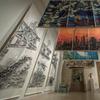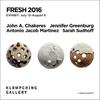Landmark Exhibition at MFA Boston Explores Asian Influence on the Colonial Americas
- BOSTON, Massachusetts
- /
- July 16, 2015
Luxurious Textiles, Crafted Lacquerwork and Blue-and-White Ceramics Highlight Asian Impact on the New World
More than 90 exquisitely crafted objects—including furniture, silverwork, textiles, ceramics and painting—are on view in Made in the Americas: The New World Discovers Asia, the first large-scale, pan-American exhibition to examine the profound influence of Asia on the arts of the colonial Americas. On view at the Museum of Fine Arts, Boston (MFA), from August 18, 2015–February 15, 2016, the exhibition features works of art from the MFA as well as loans from public and private collections.
These objects relay the complex story of how craftsmen throughout the hemisphere adapted Asian styles in a range of objects. Objects made in Mexico City, Lima, Quito, Quebec City, Boston, New York and Philadelphia, dating from the 17th to the early 19th centuries, include folding screens made in Mexico (that imitate Japanese and Chinese screens), blue-and-white talavera ceramics (copied from Chinese porcelain) and luxuriously woven textiles (made to replicate fine silks and cottons from China and India).
These works reflect the beginnings of globalism, when ships carrying explorers, and later goods, connected the world as never before. It was the first era when Europe, Asia and the Americas were interconnected through trade on a large scale. The exhibition marks the five-year anniversary of the opening of the Art of the Americas Wing, when the MFA renewed its commitment to collecting and displaying art from across North, Central and South America.
An illustrated catalogue features essays by a team of experts, including exhibition curator Dennis Carr, Carolyn and Peter Lynch Curator of American Decorative Arts and Sculpture at the MFA.
“We tend to think of globalism as a recent phenomenon, but it’s been around for centuries,” said Carr. “The wonderful objects in this exhibition encourage us to think more broadly about the Americas and the powerful influences from across the Pacific, which changed the course of history.”
The Americas became a major destination for objects made in Asia beginning in the 16th century, and Asian influences can be found in places as far apart as Boston and Peru. The timing of the exhibition marks the 450th anniversary of the Galleon trade between the Philippines and Mexico, which was inaugurated in 1565 and lasted for an astonishing two and a half centuries, until 1815. The entrance of the exhibition in the Lois B. and Michael K. Torf Gallery, includes a number of works that explore the trade routes that connected Asia and the colonial Americas. Visitors are first greeted by a pair of over 12-foot Japanese screens, titled The Southern Barbarians Come to Trade (attributed to Kanō Naizen, about 1600, private collection). Privately held in Japan for generations, the works depict the arrival of Portuguese traders in Japan and China and are shown fully restored for the first time.
Among the earliest objects made in the Americas in a distinctly Asian style were large-scale folding screens—called biombos—that were based on imported Japanese and Chinese examples. One of the earliest surviving Mexican screens, Scenes of the Conquest of Mexico / View of the City of Mexico (mid-17th century, Vera da Costa Autrey Collection, Mexico City), is displayed in the center of the exhibition and shows the plaza mayor (main plaza) of Mexico City and scenes of the Spanish conquest. Rather than being strict copies of Asian screens, biombos were made with techniques more commonly found in Mexican art, including beautiful enconchado painting (a technique of painting over mother-of-pearl inlay), as well as traditional European oil painting, gesso and gilding.
The fashion for Asian art as a decorative style, today known as the chinoiserie (meaning “in the Chinese taste”), reached its height by the mid-18th century. In the Americas, the style manifested itself in lavishly painted and decorated interiors, ornate furniture and ceramic objects made in the style of Chinese blue-and-white porcelain. In Catholic Latin America, unlike Protestant North America, chinoiserie was found in religious contexts, such as interior church architecture and furnishings. It also appeared in the embroidered textiles of the Ursuline nuns of Quebec, including the Dove of the Holy Spirit altar frontal (about 1700, Musée des Ursulines de Québec). Among the most rare pieces of furniture on view is a Desk and bookcase (mid-18th century, Ann and Gordon Getty Collection) from Mexico, which features a dramatic interior displaying chinoiserie-style painting in gold on a red background. Recalling early colonial maps drawn by indigenous artists, the inside of the doors show views of an extensive hacienda in Veracruz drawn in an indigenous style.
The fashion for japanning—a painted imitation of Asian lacquerwork on furniture and wall paneling using layers of varnish, gold paint and sometimes metallic powders —also spread throughout New England, New Spain, the Caribbean and parts of South America during the 18th century. A number of objects in the exhibition feature the technique, including the MFA’s own High chest of drawers (about 1730–40). Boston became a major center of the production of japanned furniture—where over a dozen japanners worked before 1750—but it was also made in Mexico, Guatemala, Brazil, and other port cities in the British colonies, such as New York, Philadelphia and Port Royal, Jamaica.
The indigenous lacquer of western Mexico and South America—laca (or maque) and barniz de Pasto (or mopa mopa)—was transformed by the introduction of Asian lacquerware and their European imitations. Native artisans did not have access to the tree resin needed for Asian lacquers, but they developed new painting styles and techniques using local materials, satisfying the taste for luxury objects such as finely decorated boxes, cabinets of drawers and large bateas (or trays). In particular, lacquerware from the Mexican cities of Peribán, Uruapan and Pátzcuaro, exhibited a variety of motifs adapted from European and Asian sources. A celebrated painter of noble Indian lineage, José Manuel de la Cerda, is considered the finest of all of the Pátzcuaro lacquer artisans. Works from the De la Cerda workshop show pronounced Asian influence, including a Desk-on-stand (18th century, Hispanic Society of America), painted in a chinoiserie style with exotic-looking buildings and weeping willow trees delicately picked out in gold paint on a black background.
Furniture making in Peru featured many precious materials, as demonstrated by a group of furniture inlaid with mother-of-pearl and tortoiseshell in the exhibition. Described in Spanish as enconchado (shellwork), the objects recall the elaborate Japanese shell-inlaid lacquers or fine inlaid furniture imported from India, Korea and other parts of Asia. A pair of enconchado Writing cabinets (first half of the 18th century, Colección Patricia Phelps de Cisneros) from Alto Peru (modern-day Bolivia) show that this interest in shell-inlaid woodworking extended into rural South America. Probably made by indigenous artists for the Jesuit mission churches in this remote region, the cabinets display a worldly, cosmopolitan flair that was typical of the religious order’s establishments throughout the Americas.
Southeast of Mexico City, along the trade route that brought Asian goods overland from Acapulco, a ceramics tradition in the town of Puebla flourished based on imported Chinese blue-and-white porcelains. Native craftsmen did not have access to the fine materials needed to create true porcelains, so they covered earthenware pottery with a thick, white tin glaze—in much the way potters did in Delft in the Netherlands and Talavera de la Reina in Spain during the same period—decorating it with expensive cobalt blue. In some of these ceramics, known as talavera poblana, artists replaced Chinese figures with local imagery, switching out Chinese phoenixes in favor of native quetzals (small birds with long, colorful tail feathers). In addition to depicting Chinese characters and decorative motifs, Puebla potters also adapted traditional Chinese forms, such as broad-shouldered jars (tibors), gourd-shaped vessels and thin-necked wine jars. Talavera is still made in Puebla today, continuing a tradition that has lasted more than four centuries.
In addition to ceramics, colonial silver was an important part of chinoserie style in the Americas. As imported Chinese tea became all the rage in the 18th century, a number of American craftsmen produced silver vessels in an Asian style to satisfy the demand for a host of specialized vessels, including teapots, hot-water urns, tea caddies, strainer spoons, creamers and sugar bowls—many of which are on display in the exhibition. In particular, colonial silversmiths such as John Hurd excelled at producing elegant vessels based on Chinese and English examples. Among the earliest and rarest expressions of chinoiserie style in American silver is a set of Candlesticks and Snuffer Stand (about 1705, Metropolitan Museum of Art, New York), made by New York silversmith Cornelius Kierstede. The bases are engraved with wildly gesturing figures and oversized plants and flowers, characteristic of chinoiserie designs in English silver.
Chinese silks, as well as Persian and Indian textiles were also prized in the Americas, and a variety of Asian and American textiles are included in the exhibition. A Peruvian Cover (late 17th or early 18th century, Museum of Fine Arts, Boston) is one of very few surviving examples showing the influence from Chinese export textiles, with imagery taken directly from Chinese silk embroideries of the Ming and Qing Dynasties exported in the 17th century. The Peruvian weavers skillfully incorporated traditional Chinese figures, such as peony flowers, paired phoenix birds and the mythical xiezhi, with flora and fauna indigenous to Peru. The prominent use of red in the background—an auspicious color in China—is made using cochineal, a brilliant carmine dyestuff made in Peru from tiny cochineal insects harvested from cacti.
To be a colonial citizen in the Americas was to be a global citizen, as embodied by a number of paintings in the exhibition. For example, a portrait from Mexico, María de los Dolores Juliana Rita Nuñez de Villavicencio (about 1733, Carlos de Ovando Collection), shows a young noble woman wearing an embroidered dress with a menagerie of imagery from China, Europe and the Near East. Chinese men, exotic-looking animals, military tents, and oversized flowers and trees were all part of the chinoiserie vocabulary when this fashionable style found its way to Mexico in the 18th century. A portrait of Nicholas Boylston (about 1769, Museum of Fine Arts, Boston) by John Singleton Copley shows the Bostonian as a wealthy man at leisure––the embodiment of the era’s global merchant. His red velvet turban and silk morning gown (banyan or Indian coat) were the clothes of a gentleman. His firm, Green and Boylston, became extremely successful in the 1760s, importing textiles, paper, tea and glass that were eagerly sought by Bostonians. This painting is paired with another from Mexico, De Español y Negra, Mulato (about 1760, attributed to José de Alcíbar, Denver Art Museum), which also shows its subject wearing a long coat in an Asian style. In this case, the robe is made of embroidered or printed Indian cotton or muslin, but it is difficult to know whether the fabric was made in India, was a European copy or was of local origin. It, like many works in the exhibition, reflects the global story of trade and artistic influence found in the colonial Americas.















![Peter Paul Rubens (Flemish, 1577–1640), After Titian (Tiziano Vecelli) (Italian [Venetian], c. 1488–1576), Rape of Europa, 1628–29. Oil on canvas, 71 7/8 x 79 3/8 in. Peter Paul Rubens (Flemish, 1577–1640), After Titian (Tiziano Vecelli) (Italian [Venetian], c. 1488–1576), Rape of Europa, 1628–29. Oil on canvas, 71 7/8 x 79 3/8 in.](/images/c/e2/2e/Jan20_Rape_of_Europa100x100_c.jpg)
